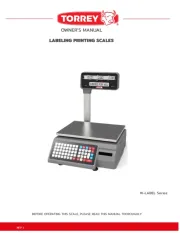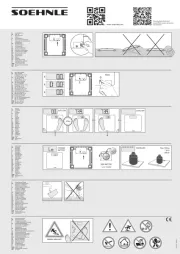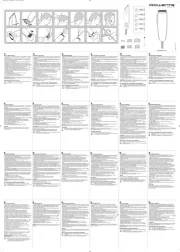Conair Weight Watchers WW66 Handleiding
Conair
Weegschaal
Weight Watchers WW66
Bekijk gratis de handleiding van Conair Weight Watchers WW66 (12 pagina’s), behorend tot de categorie Weegschaal. Deze gids werd als nuttig beoordeeld door 38 mensen en kreeg gemiddeld 4.4 sterren uit 19.5 reviews. Heb je een vraag over Conair Weight Watchers WW66 of wil je andere gebruikers van dit product iets vragen? Stel een vraag
Pagina 1/12

Instructions
for use of
Weight Watchers
bathroom scale
Congratulations! By purchasing this Weight Watchers Scale, you’ve made
the first step toward taking control of your weight. To get the greatest benefit
from your purchase, please read this entire brochure before using your scale.
Scales by
™
Models #WW66, WW68

Weight and Body Fat
How does it work?
While body fat can be measured in many ways, the method used in your scale
is bioelectrical impedance. This indirect method of determining body fat starts when
a safe and very low electrical current is sent through the lower half of the body.
The electrical current flows more quickly through water and muscle than it will
through bone and fat. The scale measures the speed of the current. Based on this
number, the scale estimates body fat using a multi-step, mathematical formula.
Is it accurate?
Measurements of body fat tend to fluctuate a lot more than simple weighing,
and different methods of estimating body fat yield very different results. Just as
different scales give different results, different body fat analyzers can provide
very different body fat estimates. Even with the same scale the numbers will
vary because:
• Weight loss tends to produce substantial, continuous, and unpredictable changes
in body water content. Because body fat analysis is determined by water content
in the body, results can vary considerably from day to day.
• Hydration status affects body fat results. If you’ve just worked out, there is less
water for the electrical current to flow through. This may result in a higher body
fat result. In the same way, if you measure your body fat after drinking a lot of
fluid, it may appear that body fat is lower than it really is.
• Skin temperature can have an influence also. Measuring body fat in warm humid
weather when skin is moist will yield a different result than if skin is cold and dry.
• As with weight, when your goal is to change body composition it is better to track
trends over time than to use individual daily results.
• Results may not be accurate for persons under the age of 16, or persons with
an elevated body temperature, diabetes or other health conditions.
What you need to know!
• Percent body fat refers to the number of pounds of fat divided by your total body
weight and multiplied by 100.
• During weight loss, percent body fat doesn’t appear to be reduced as quickly
as expected because total weight loss and total body fat are decreasing at the
same time (for a more detailed explanation, see next section).
• Weight loss in the form of body fat and lean tissue (muscle) is common, and
is normal.
• To minimize the loss of lean tissue, include regular physical activity, especially
strength training, in your weight-loss plan.
Why do I lose weight but my body fat percentage doesn’t change much?
Most body fat monitors show body fat as a percentage only. This body fat
monitor shows you not only a percentage but the actual number of body fat
pounds (in fact, this is the measurement you see after your weight is displayed).
Why is that important? When you lose weight, both the numerator (pounds of
body fat) and denominator (total body weight) go down, so when it’s calculated as
a body fat percentage, the number can be small. For example, a person may weigh
200 pounds and have 40% body fat (= 80 pounds of body fat). He/She loses
20 pounds, but the body fat has only dropped 4% to 36%. That 4% of body fat was
16 pounds of fat – a very significant amount! So do not be overly concerned if you
do not see the percentage change quickly as you are losing weight: monitor the
absolute number of body fat pounds lost. Remember, to minimize the loss of
lean tissue, include regular physical activity, especially strength training, in your
weight-loss plan.

BMI – What Is It?
BMI stands for Body Mass Index, a statistical term derived from height and weight.
It is closely linked to body fat and health outcomes. Over 50 organizations,
including the US Government and the World Health Organization, have adopted
BMI guidelines. BMI is inversely related to fitness, meaning that the higher your
BMI, the less likely you are to be fit. Every time your body analysis monitor reads
your weight and calculates your body fat, it also calculates your BMI. Along with
your weight and your body fat measurements, the BMI reading gives you yet one
more tool to monitor your health and fitness.
Body Water/Hydration Levels
General health standards indicate that one should consume approximately
64 oz of water per day from food and liquids to maintain a healthy level of hydra-
tion. Maintaining a good hydration level will help improve your overall health and
general feeling of well-being. If your hydration levels are lower than average, you
should increase your water intake accordingly.
Body water/hydration level – how is it measured?
The hydration level is measured by using Bioelectric Impedance Analysis (BIA).
The same analysis that is used to calculate your body fat is used to calculate your
hydration level. Taking into consideration a user’s age and gender, a calculation is
made that determines the percentage of water.
Please note: It is not recommended to take the hydration measurements in
certain situations, such as following exercise, after drinking a glass of water, or
directly prior to, during or shortly after menstrual cycles. Hydration may not be at
normal levels during these times.
Bone Mass – What Is It?
Bone is a living, growing tissue. During youth, your body makes new bone tis-
sue faster than it breaks down older bone. In young adulthood, bone mass is at
its peak; after that, bone loss starts to outpace bone growth, and bone mass
decreases. But it’s a long and very slow process that can be slowed down even
more through calcium-rich diets and weight-bearing exercise.
Who should monitor bone mass?
Most people have no need to monitor bone mass, but certain groups – post-
menopausal women, men and women with certain diseases, and anyone who
takes medications that affect bone tissue – might want to watch for decreases in
bone mass. The bone mass reading is to be used as guide only. Watch for trends
over time and contact your healthcare provider for a more detailed explanation of
the readings and with any questions or concerns.
Product specificaties
| Merk: | Conair |
| Categorie: | Weegschaal |
| Model: | Weight Watchers WW66 |
Heb je hulp nodig?
Als je hulp nodig hebt met Conair Weight Watchers WW66 stel dan hieronder een vraag en andere gebruikers zullen je antwoorden
Handleiding Weegschaal Conair

30 September 2024

30 September 2024

4 September 2024

4 September 2024

4 September 2024

4 September 2024

4 September 2024

4 September 2024

4 September 2024

9 Juli 2023
Handleiding Weegschaal
- Mitsukota
- Brecknell
- ECG
- Ade
- Garmin
- Laica
- Optima Scale
- Kern
- Testo
- GOTIE
- PCE Instruments
- EMOS
- Maman
- Gorenje
- Sencor
Nieuwste handleidingen voor Weegschaal

25 Augustus 2025

18 Augustus 2025

18 Augustus 2025

18 Augustus 2025

16 Augustus 2025

15 Augustus 2025

15 Augustus 2025

15 Augustus 2025

15 Augustus 2025

15 Augustus 2025